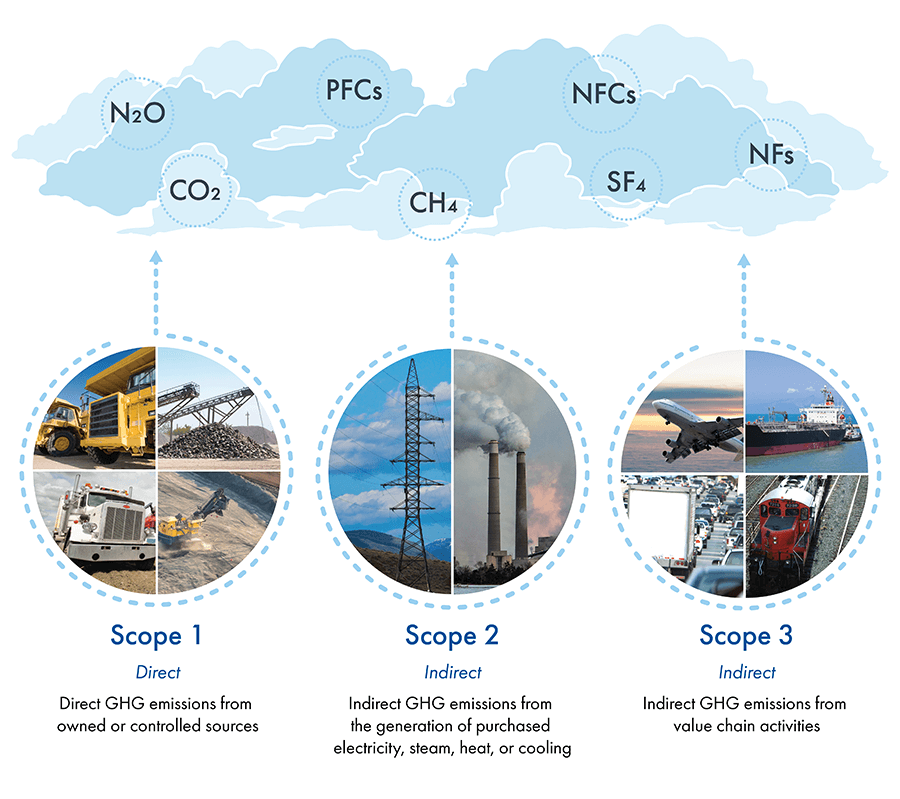Greenhouse gas (GHG) emissions and carbon footprints are a growing area of focus for many economic sectors in the United States and around the world. The carbon footprint of products may influence how environmentally conscious consumers spend and how lenders invest their money. As a result, many industries are incorporating environmental initiatives to reduce GHG emissions. Food product manufacturers are requesting GHG information from their supply chain to define and improve their carbon footprints and meet environmental, social, and governance (ESG) objectives.
Developing a carbon footprint through GHG accounting is not a standard procedure. It varies between industries and from facility to facility, depending on the activities that occur; however, many agricultural processing facilities across the country share some common practices and activities that can be useful when developing a carbon footprint.
Five steps to develop a GHG inventory
1. Set organizational boundaries.
The first step is setting organizational boundaries for facilities with joint operations to avoid double counting (e.g., two companies holding interest in a joint operation). You can determine boundaries based on operational control or equity share.
2. Set operational boundaries.
The next step is to set boundaries based on the typical flow of operations. For agricultural manufacturing facilities, this generally includes agricultural inputs, agricultural operations, transportation to factory, factory operations, other factory inputs (such as raw materials or chemicals), and factory outputs.
3. Determine Scope 1, 2, and 3 emission sources.
From the operational boundaries identified above, you can organize GHG emission sources into three scopes based on the criteria outlined in the GHG Protocol1. Scope 1 emissions are those directly resulting from the operations. Common Scope 1 emissions include factory fuel combustion, vehicle emissions, and agricultural practices, such as fertilizer application. Scope 2 emissions are from third-party electricity suppliers. Scope 3 emissions include downstream and upstream sources, such as GHGs from the manufacturing of purchased fertilizer or third-party transport of products to the end users. It is common for companies to start with Scope 1 and Scope 2 inventories before pursuing Scope 3.
 As outlined in the GHG Protocol, GHG emission sources can be organized in three scopes.
As outlined in the GHG Protocol, GHG emission sources can be organized in three scopes.
4. Quantify emissions.
Site-specific emission factors and inputs are ideally used to develop a GHG inventory. These emission factors may be based on stack testing, material balances, or analytical results. You can base inputs on accounting or other facility operational records.
Although some calculations may be complex, the equation to quantify emissions is relatively simple: Emissions = Emission Factor x Activity Throughput.
Although some calculations may be complex, the equation to quantify emissions is relatively simple: Emissions = Emission Factor x Activity Throughput.
There are a few best practices to keep in mind for emissions factors. As mentioned previously, use site-specific data when possible, such as monitoring data and analytical data. Another way to establish emission factors is through published emission factors, including AP-42 and 40 CFR Part 98. If these first two methods don’t apply, you can use the Intergovernmental Panel on Climate Change Published Guidance, Environmental Protection Agency guidance, or other studies, or use engineering judgement to set your emission factors. Similarly, activity throughput is also more accurate when using site-specific data when possible (e.g., monitoring data and accounting records). You can also refer to market studies and engineering judgment to make assumptions for throughput when needed.
5. Update, review, and refine.
Once you develop a GHG inventory, there should be a regular process to update, review, and refine your GHG accounting information. To keep your GHG inventory up to date and accurate, consider updating your inventory, reviewing emissions, refining calculations, implementing emission reductions, and repeating this process annually. Keep in mind that an annual review is a good goal to have; however, the appropriate frequency may depend on your reasons for developing a GHG inventory in the first place.
Meeting sustainability and ESG objectives
As a facility develops and tracks its GHG inventory, the information may be used to provide carbon footprint information to consumers and suppliers, develop marketing materials to communicate sustainability initiatives, and identify sources for GHG reductions. GHG inventories serve as an important tool to document, track, and implement sustainability objectives and to provide transparency to stakeholders.
If you’re looking for a partner to help you get started with GHG accounting, Barr’s team of experienced environmental specialists can help you assess your operations and calculate your GHG inventory. Contact us to learn more about how we can assist you with achieving your ESG goals.
About the authors
Taryn DeRosia is a chemical engineer with five years of experience helping clients meet regulatory requirements for air, water, and waste. She provides assistance with routine compliance requirements in the agriculture and food product sector, such as permit applications, routine reporting, technical program evaluations, and regulatory agency communications.
Allison Serakos, environmental scientist, helps Barr’s clients solve complex problems in air, water, and climate programs. Her project work involves assessments related to GHG emissions and climate change, GHG reduction strategy development, air dispersion modeling, meteorological data analysis, and forecast model development. Before joining Barr, Allison completed her Master of Science in Land and Atmospheric Science, with a focus on upper atmospheric and climate dynamics.
1 "Greenhouse Gas Protocol." World Resource Institute (WRI) and World Business Council for Sustainable Development (WBCSD). https://ghgprotocol.org/.